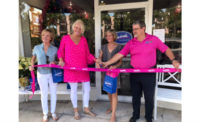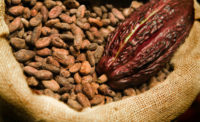Jean Thompson is the first to say she knew nothing about making chocolate when she took over Seattle Chocolates 16 years ago.
But the former Microsoft corporate communications manager had other things going for her. She knew how to market a product, that people enjoy eating chocolate and that a once-in-a-lifetime opportunity was staring her in the face.
“If somebody wasn’t willing to step up, it would’ve been the end,” said Thompson while seated in a robin egg-blue conference room at Seattle Chocolate’s headquarters in Tukwila, Wash. “It would’ve been easy to walk away from it, but we believed in the machines, believed in the product. As investors we thought this deserves another try.”
At-a-Glance: Seattle Chocolates
Headquarters: Tukwila, Wash.
Sales: $15 million (Candy Industry estimate)
Employees: 70
Products: Truffles, truffle bars, Frango mints
Management team: Jean Thompson, owner and ceo
In 2001 — around Seattle Chocolates’ 10-year anniversary — the 6.8-magnitude Nisqually earthquake jostled Seattle, Tacoma, Olympia and other parts of the Pacific Northwest. The quake separated the walls and ceiling of Seattle Chocolate’s facility in SoDo, a neighborhood south of downtown Seattle. The building had to be condemned.
Thompson, who served as one of the company’s dozen investors at the time thanks to her position at Microsoft, decided to intercede at that critical moment.
“Somebody had to move the company in an emergency way — save the machines — and that took a lot of money,” she said. “We as a family decided to step up and became the majority owners at that point.”
Production moved to a building in Seattle’s South Park neighborhood, and Thompson got involved in day-to-day operations a year later. Having trips to Costco as her only warehouse experience, she faced a steep learning curve. But with help from an experienced staff, Thompson was ready to take it on.
“I figured it’s chocolate, I understand the consumer, I understand the product in terms of a taste experience, so I’ll learn the rest,” she said.
And so she has. Over the last decade and a half, Seattle Chocolates relocated to a 60,000-sq.-ft. facility south of Seattle, achieved a handful of certifications and launched jcoco, a new, culinarily-minded brand that’s just as fun and colorful as Thompson herself.
Thompson has taken it a step further, however. To celebrate the company’s 25th anniversary — and build a connection with customers — Seattle Chocolates remodeled its retail store and opened the factory to daily tours featuring tastings, educational components and a view of production and warehousing from a new, magenta mezzanine.
Plans for the project began a year ago, Thompson says. After encountering people who didn’t know about chocolate bloom, Rainforest Alliance cocoa or even Seattle Chocolates, Thompson wanted to reach out.
Still, she had her doubts. Noting that employees are often covered “head to toe” in chocolate and machines often require repair during production, she feared giving the impression of an amateur operation — even if that’s far from being the case.
Seattle Chocolates has a Level 2 Safe Quality Food (SQF) certification and an “excellent” rating, according to the SQF Institute’s database. Moreover, Seattle Chocolates is a certified woman-owned business through the Women’s Business Enterprise National Council, an organization that promotes diversity in commerce.
Putting it all on display gives visitors and customers an authentic — and likely endearing — experience, Thompson says.
“The best way to develop a following or a relationship with your consumer is to open up your doors and invite them into your house,” she says. “Once they’re in here, they understand how difficult it can be and also how many people have jobs because of Seattle Chocolates. Let’s get them in here, introduce ourselves to them and at the same time we get to know them a little bit, too.”
Construction on the retail store and mezzanine began in June 2016 and wrapped in December.
Thompson said the construction was a “little disruptive” but manageable.
“We were all schlepping to the other side of the building to use the restrooms for probably six months, but everybody was excited about why we were doing it, so it made it tolerable,” she said.
The remodeled retail store features polished concrete floors, wood displays and industrial fixtures — the perfect neutral background for Seattle Chocolates’ bright and colorful packaging. Visitors can sample chocolate, make purchases and sign up for tours at a bar with matching wood paneling and a metal frame.
Thompson said tours began in mid-January, and so far, the feedback has been positive. They start in a room dedicated to tasting and education, where visitors view videos about the history of chocolate and follow Adrien Kuadio, a Cote D’Ivorian cocoa farmer involved in the Rainforest Alliance.
Seattle Chocolates has used Rainforest Alliance-certified cocoa for the last few years. While it means more expensive chocolate for the company and its consumers, Thompson sees the value in it.
“We’re voting with our pocketbook,” she says. “We’re saying this matters to us. We want cacao trees to be around, we want there to be enough cocoa for the world’s growing hunger and desire, and we want the people who do that hard work to be taken care of.”
After the videos, a tour guide leads visitors past a wall featuring Lucille Ball and Vivian Vance in the infamous “I Love Lucy” chocolate-packing scene and up to the magenta mezzanine.
From the mezzanine, visitors can see all aspects of the business, from production to packaging. At two points, there are informational panels and videos explaining how Seattle Chocolates makes its signature truffles and truffle bars.
The company uses a Carle & Montanari depositing, moulding and cooling line to create more than 20 flavors of truffles in 300-lb. batches. However, employees press inclusions into 40-piece trays by hand.
For the bars, Seattle Chocolates uses an Aasted FrozenCone depositing and cooling line, which allows the company to make 30,000 bars in a 10-hour shift. Chocolate is gravity-fed from Aasted melters and tempering machines to both lines.
A Sapal fold wrapper is used for the Seattle Chocolates bars, while a Sig wrapper is used for the jcoco line. Two PacTec wrappers are run at half capacity for the truffles.
Much of Seattle Chocolate’s production — 1 million pounds a year — is devoted to its own items, but the company also produces Frango mints on a contract basis. Garrett Brands bought the brand from Macy’s earlier this year, and Seattle Chocolates has been meeting with Garrett, Thompson says.
At the end of the tour, visitors get a chance to taste chocolate. On a Monday in early April, six items were set out for guests: the Seattle Chocolates Pike Place Espresso, San Juan Sea Salt and Fresh Mint bars, the jcoco Black Fig Pistachio and Cayenne Veracruz bars, and, of course, a Frango mint.
Thompson describes the 25-year-old Seattle Chocolates line as “comfortable,” with flavors like espresso, mint and salted almond. The jcoco line, meanwhile, features ingredients paired as they would be by chefs. Among the jcoco offerings are:
- Noble Dark: 72% dark chocolate with cocoa nibs
- Agave Quinoa Sesame in Milk Chocolate
- Edamame Sea Salt in Milk Chocolate
- Bali Sea Salt Toffee in Milk Chocolate
- Vanuatu Coconut Pecan in Milk Chocolate
- Cayenne Veracruz Orange in White Chocolate
- Black Fig Pistachio in Dark Chocolate
Last year, Seattle Chocolates introduced the jcoco Dark Chocolate Arabica Cherry Espresso Bar, which features CoffeeFlour, a powder created by grinding the “cherry” surrounding Arabica coffee beans.
The concept, developed by a former Starbucks employee, helps eliminate waste, since the cherries are typically thrown out during harvest. It packs a nutritional punch, since Arabica cherries are loaded with protein, fiber and antioxidants.
Though incorporating the cherries’ high fiber content required a year and a half of product development, Thompson says the flavor naturally pairs well with dark chocolate.
“A lot of people think it’s a much higher percent cacao than it is,” she says. “We deliberately put that in a 60 (percent) because it does taste more like a 70 percent. You really get a cocoa forward flavor profile. People love it.”
Seattle Chocolates has also unveiled three new jcoco chocolate tasting flights. Featuring three 1-oz. bars, the handmade flights explore cocoa sourcing and cacao and cocoa butter percentages. Each bar includes a pocket-sized manual of tasting notes and inventive pairing suggestions created by Jason Wilson, the James Beard Award-winning chef of Miller’s Guild in Seattle.
They include:
- The Complex Dark Chocolate Tasting Flight: Explores different variations of cacao from 70 percent to 86 percent in taste, aroma, mouthfeel and tannin content.
- The Precious Metals Milk Chocolate Tasting Flight: Explores the nuances that cocoa butter and milk lend to a chocolate’s flavor, bringing forth notes of creaminess, caramel and toast.
- South American Dark Chocolate Tasting Flight: It features a 62 percent cacao bar from Peru, a 68 percent cacao bar from Brazil and a 72 percent cacao bar from Venezuela. Each embodies the flavors typical of the soils, climate and environment from where the cocoa was grown.
At $13 each, Thompson says the flights appeal to “foodies” and connoisseurs who seek the origin stories behind the complexity of craft chocolate products.
Thompson plans to learn more herself by traveling to countries that produce cocoa. The goal, she says, is to host pairing events, and ultimately, give chocolate the esteem wine enjoys.
“What we want to do is celebrate it and understand just how complicated it is in terms in its flavor potential,” she says. “We need to elevate its image and the discussion around it in keeping with what it brings to the table. It’s worthy of that.”































